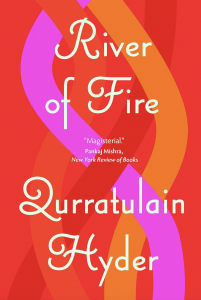by MICHAEL MCGURK

Qurratulain Hyder, River of Fire (New Directions, 2019), pp. 448
“Human nature would never change, men would continue to hate and kill one another.”
This prophecy, delivered in River of Fire by a Muslim scholar amid the catastrophic Indian Rebellion of 1857, serves as an apt summary for Qurratulain Hyder’s 1959 Urdu epic. Republished this year by New Directions, River of Fire traces the prehistory of the partition of India over more than two thousand years of violence and political conflict. In this novel that beautifully blends narrative and poetry, history and philosophy, politics and religion, Hyder follows a group of characters as they reappear in key moments of Indian history: from the Maurya conquests of the Iron Age, through the years of the Delhi Sultanate and the British Empire, and finally to the era of Indian nationalism and the partition. As interpersonal drama plays out between a recurring cast of characters—Gautam, Nirmala, Champa, and Hari Shankar—so too does a greater historical drama unfold before our eyes.
While Hyder is widely adored in India and regarded as one of the central figures of modern Urdu fiction, one has to wonder whether the novel might not have made her an international literary figure had its English “transcreation” been published four decades earlier. Much to its detriment, the establishment of English literary studies would not seriously consider the works of Indian writers until the publication of Salman Rushdie’s Midnight’s Children in 1981. Many critics suppose that the arrival of novelists like Rushdie and Gabriel García Márquez—another author to whom Hyder is anachronistically compared—onto the international literary stage marked the beginning of a new “world literature.” However, River of Fire demonstrates that the Cold War’s “Third World” possessed a desire and an ability to see and speak globally long before the First World noticed. Moreover, in Hyder’s pastiche of literary and discursive styles and her inventive synthesis of historical and biographical timelines, the contemporary reader can discern the emergence of the postmodernist novel.
The novel, considered a well-loved classic of Urdu fiction long before the author “transcreated” the text into English in 1998, accomplishes what few novels can: It narrates individual human lives with intimate and earnest detail, but also situates the personal within a longer history of war, conquest, oppression and rebellion. In calling the English edition a “transcreation,” in fact, Hyder acknowledges the living continuities of her narrative. In each moment, a character will rediscover, for instance, the cruelty of class and caste, the debilitating effects of patriarchal society, the mundane violence of foreign rule. And every moment both recalls and portends past and future moments of historical recognition, linking each character to others in distant eras. Indeed, much of what River of Fire has to say about India’s earlier political history still rings true today, which makes this year’s republication all the more timely.
Above all, River of Fire demonstrates the continuity of all human experience—its joys and its miseries alike. Even as the novel asks us to consider the essential timelessness of human suffering, Hyder manages also to portray each historical period with a great degree of cultural, political, and social specificity. For instance, when the narrative moves to early modern Jaunpur, Hyder offhandedly gives the “[b]azaar rates as of today: wheat, one maund for one tanka; 20 sers of pure ghee: one tanka. Rice, three maunds: one tanka.” The novel not only paints the broad strokes of Indian history but also attends to the finer points of arts and literature, fashion and cuisine, religion and commerce. Anyone unfamiliar with Indian history and society will learn much through this text, which occasionally interrupts its narrative to provide scholarly footnotes, as when Hyder informs the reader that one character’s lullaby is “still sung in Uttar Pradesh at childbirths and weddings.”

For all that, Hyder’s rich and nuanced literary voice keeps the erudite narrative from reading like a history textbook. Adroit and flexible, her free indirect style is often attuned to the discursive modes of the period. For instance, in the early chapters that follow Gautam the ascetic Vedic scholar, Hyder’s style imitates the lyrical invocations of religious scripture: “The picture of the world was merely the Self which had been painted on the canvas of the Self.” When her narrative follows the leftist students of the period just before independence, the novel embodies the verve and enthusiasm of a radical manifesto.
To that point, the political horizons of this novel are impressively wide. River of Fire resists the strictures of national allegory that mark so much postcolonial fiction of the mid-20th century and instead offers a narrative of globalization avant la lettre. Hyder’s Lucknow, where most of the novel takes place, is the site of continual cultural and social exchange:
“The ancient Hindu-Buddhist-Jain, the intermediary Turco-Mughal-Iranian and the latter-day British features of Indian civilization were so intermingled that it was impossible to separate the warp and woof of the rich fabric.“
Even in the earliest chapters, set in the fourth-century BC, Buddhist and Jain monks cross paths with scholars of Greek philosophy, who bring news from the Hebrews and Persians. Later, when the threat of partition appears and nationalist animosity between Hindus and Muslims simmers, Lucknow offers a multicultural and syncretic refuge.
As an Urdu writer living between India and Pakistan, Hyder was perhaps less interested in building and reinforcing national mythologies than in illustrating the ambiguities and admixtures that sustain and animate any great society. While nationalists begin “talking of Ancient Hindu Culture and the Glory-that-was-Islam,” Hyder looks to those lives that are caught in the middle, irreducible to easy political categories and therefore most vulnerable to state violence. In the final chapters of the novel, Kamal, a Muslim from Lucknow who studied Britain while the partition took place, returns home to find himself a stranger both in India and in Pakistan. Like so many persons displaced in the postwar period by decolonization, “he was now stateless.” The despair of forgotten lives caught between enormous political forces resonates even now as we are reminded of the precarious legal position of today’s refugees.
River of Fire is indeed a novel ahead of its time. The Anglophone world only first read Hyder years after Rushdie, Arundhati Roy, Amitav Ghosh and others built a reputation for the Indian novel in English, but this makes her work no less groundbreaking. A novel spanning centuries and incorporating the politics, religion, literature and art of numerous cultural traditions, the text can safely lay claim to world-literary status, which its belated “transcreation” into English can only affirm. River of Fire might grant Qurratulain Hyder entry into several literary traditions (Urdu and English, Indian and Pakistani), but the one that perhaps best suits her is the world.

